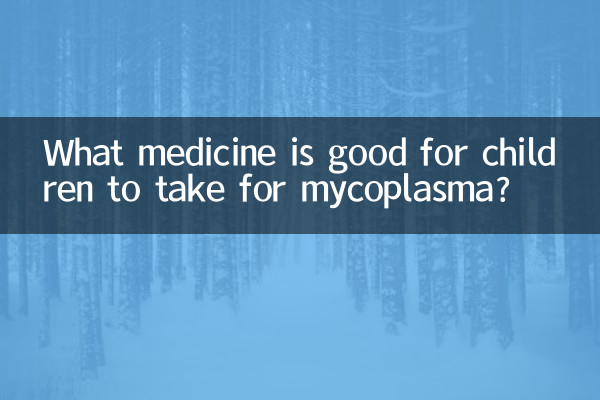What medicine is good for children to take for mycoplasma?
Recently, mycoplasma infection in children has become a hot topic of concern to parents. Mycoplasma is a microorganism between bacteria and viruses that often causes respiratory infections, especially in children. For the treatment of mycoplasma infection in children, drug selection needs to be cautious. This article will provide you with structured data and suggestions based on the hot discussions on the Internet in the past 10 days.
1. Common symptoms of mycoplasma infection

Mycoplasma infection is more common in children over 5 years old. Symptoms include:
| Symptoms | Description |
|---|---|
| cough | Severe dry cough that worsens at night |
| Fever | Mainly moderate to low fever |
| sore throat | accompanied by swallowing discomfort |
| headache | Common in older children |
| Weakness | Reduced activity level |
2. Commonly used drugs for treating mycoplasma
Mycoplasma is naturally resistant to β-lactam antibiotics (such as penicillin), and the following drugs need to be used:
| drug type | Representative medicine | Applicable age | Course of treatment | Things to note |
|---|---|---|---|---|
| macrolides | Azithromycin | ≥6 months | 3-5 days | Take on an empty stomach |
| Tetracyclines | doxycycline | ≥8 years old | 7-10 days | Avoid sun exposure |
| Quinolones | Levofloxacin | ≥18 years old | 7-10 days | Use with caution in children |
3. Precautions for drug use
1.Azithromycin: Currently the first-line drug, the common dose is 10mg/kg/day, used for 3 days. It may cause gastrointestinal reactions. It is recommended to take it with food to relieve discomfort.
2.alternative: When resistant to macrolides, children over 8 years old may consider doxycycline, 2 mg/kg/day, taken in 2 divided doses.
3.banned drugs: Never take cough medicines by yourself, especially those containing codeine, which may inhibit breathing.
4. Adjuvant treatment measures
| measures | Specific methods | function |
|---|---|---|
| Rehydration | Drink small amounts of water frequently | thin sputum |
| atomization | Normal saline atomization | relieve cough |
| Nutrition | high protein diet | Enhance immunity |
| rest | Get enough sleep | promote recovery |
5. Recent hot topics of concern to parents
1.Increased drug resistance: It has been reported in many places that the macrolide resistance rate exceeds 80%. Doctors recommend evaluating the efficacy after 3 days of treatment and prompt follow-up if it is ineffective.
2.mixed infection: Mycoplasma and influenza virus co-infections are common this winter. If high fever persists, investigation is required.
3.Precautions: There is currently no targeted vaccine. Respiratory protection is required and avoid gathering places.
6. When Do You Need Medical Treatment?
You should seek medical attention immediately if the following conditions occur: persistent high fever for >3 days, shortness of breath (>40 times/min), listlessness, food refusal, dehydration, rash or joint swelling and pain, etc.
7. Summary of Expert Suggestions
1. The diagnosis requires a combination of clinical manifestations and serological testing, and blind use of medication is not recommended.
2. Observe cough frequency and temperature changes during treatment, and keep a symptom diary.
3. Kindergarten children are advised to rest for 2-3 days after symptoms disappear before returning to kindergarten.
4. Maintain isolation within the family to avoid cross-infection.
Although mycoplasma infection is common, scientific medication and care are key. Hopefully the structured data in this article will help parents make informed decisions. Remember, any drug use must be under the guidance of a physician.

check the details

check the details